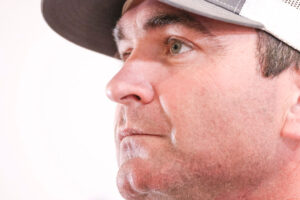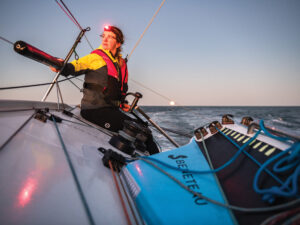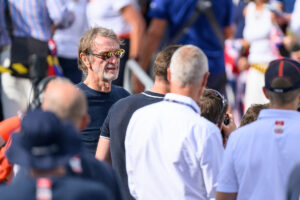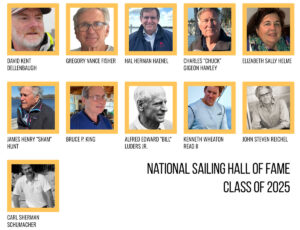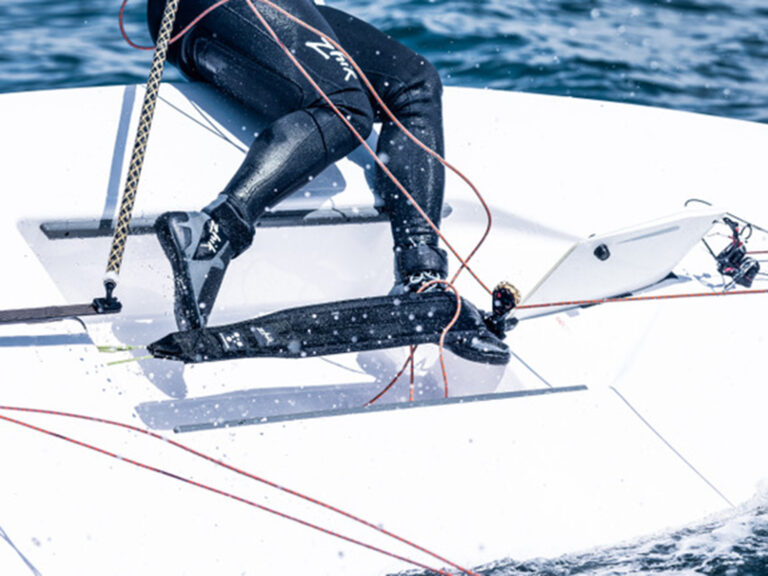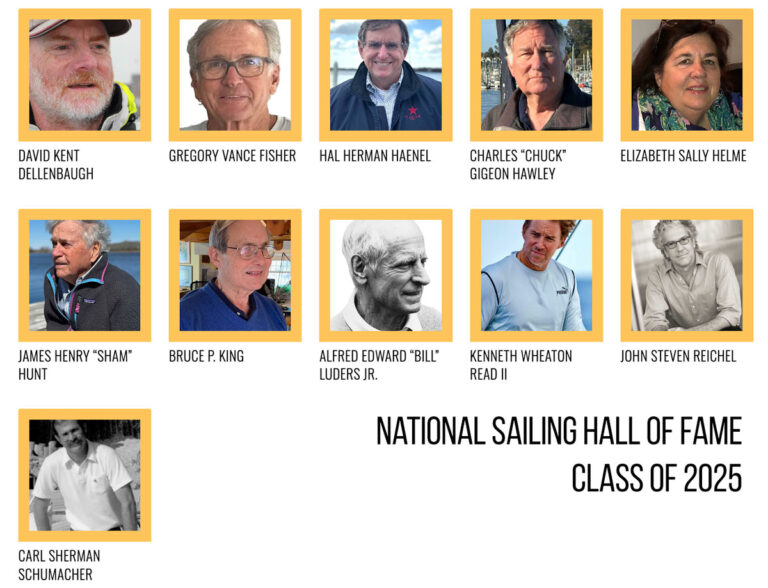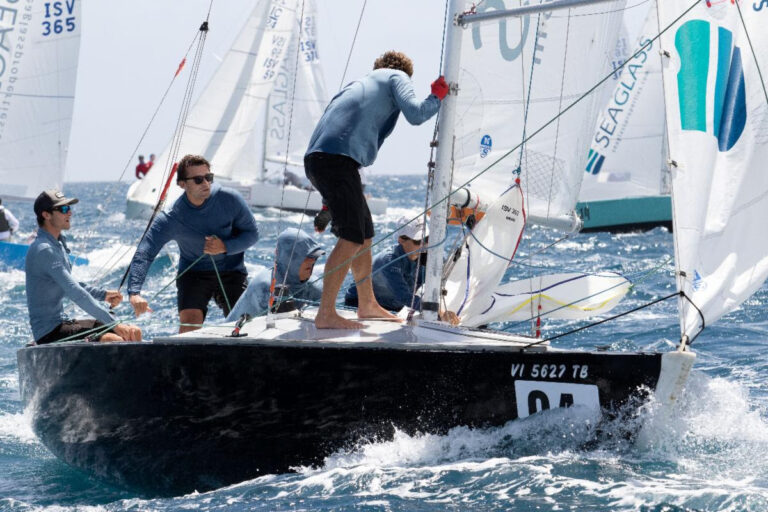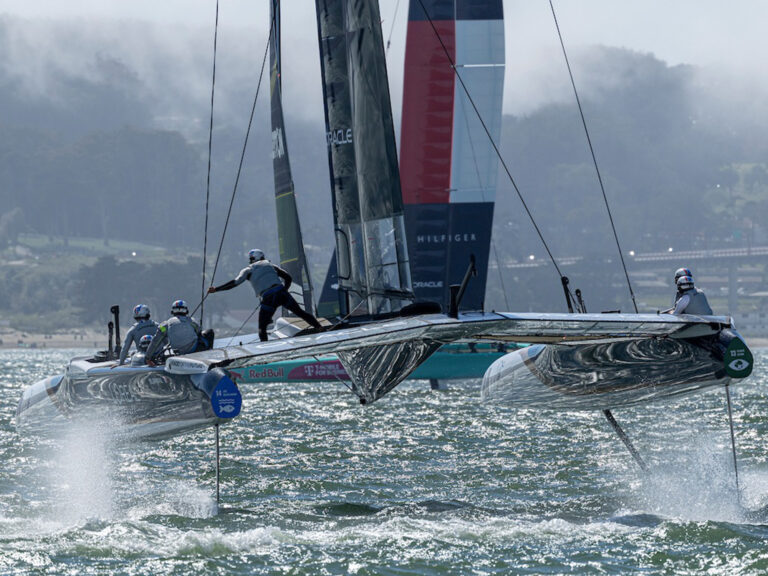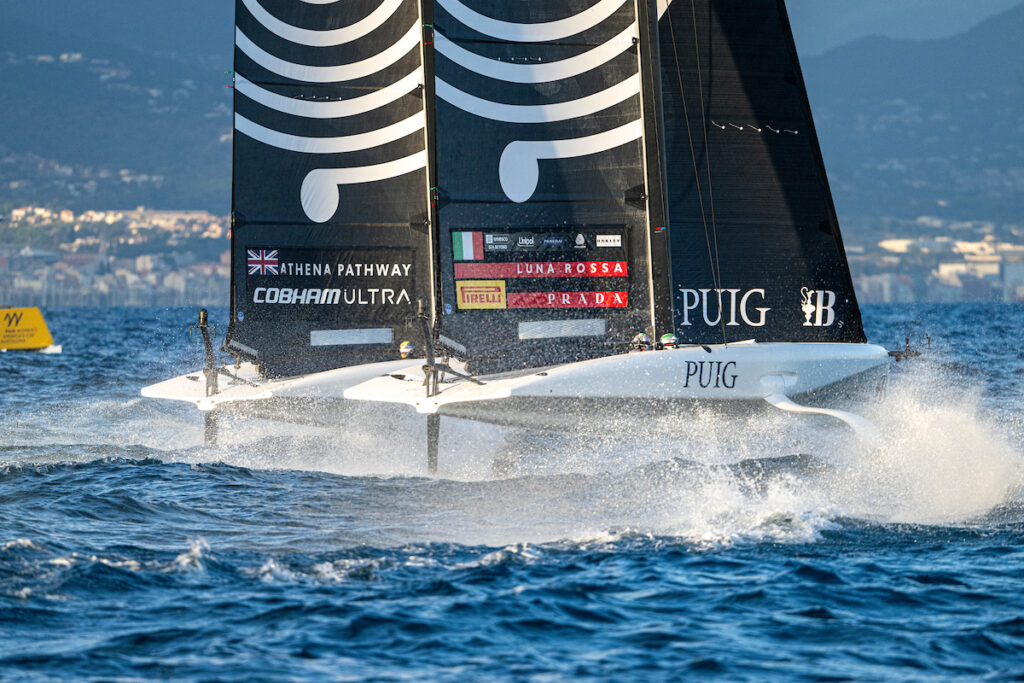
Giulia Conti, a four-time Olympian and winning skipper of the Puig Women’s America’s Cup, admits she was uncomfortable with the speed of the AC40—at first. “But then it becomes a habit,” she says. “Everything becomes automatic.”
What didn’t come automatically was efficient communication between Conti and her three teammates on the Luna Rossa Prada Pirelli women’s team. Each of them were confined to their respective seats on the foiling 40-footer, two per side, unable to see or know what was happening on the opposite side of the boat. “You have to develop such trust in a short amount of time,” she says.
And when things are happening fast, as they were on the impossibly short racecourses of Barcelona, there’s no time to talk things through, especially in their native tongue. “Italian can be so long when you speak,” Conti says. “On the first day people were talking so much, so our coach said, ‘OK, from tomorrow, you speak English on the boat.’ Because everything happens very quickly, and you have to be very clear what you communicate.”
This was especially true in the dizzying pre-starts alongside five other teams with a mix of experience and unpredictability.
Starting was, “crazy sometimes,” Conti says. “I was the starboard driver, so I had no idea who was below us—and absolutely no idea how far or close they were. Afterwards, watching the videos, I was like, thank God I did not see that, because that was close.”
It was probably for the best that Conti was blind to the near misses and sometimes spastic boathandling of the more inexperienced teams on the racecourse. Unpredictability was the nature of this first-ever AC40 women’s regatta, in which the more practiced of the 12 teams ascended to the top of the leaderboard as the series progressed, culminating in a thrilling two-boat winner-take-all final race. Won, of course, by Conti and her teammates.
Separate vs Equal
Breaking into the America’s Cup circle isn’t easy, especially for females, so the Puig Women’s America’s Cup was a necessary means to at least crack open the door, says American Magic AC40 port helmswoman Francesca Clapcich. “It helped to get people there. If it doesn’t happen organically, somehow you have to push it.”
While half of the Puig women’s teams had no direct associations with a Cup challenger or defender (referred to as the “invited” teams), even those with Cup team affiliations experienced different levels of support and access. When Conti and her teammates first arrived at the Luna Rossa compound, the inclusion of women “felt like something imposed by the America’s Cup,” she says. But soon, most of the team “started to see…and they welcomed us as a family. People were very friendly and very keen to help. Never said no to anything.”
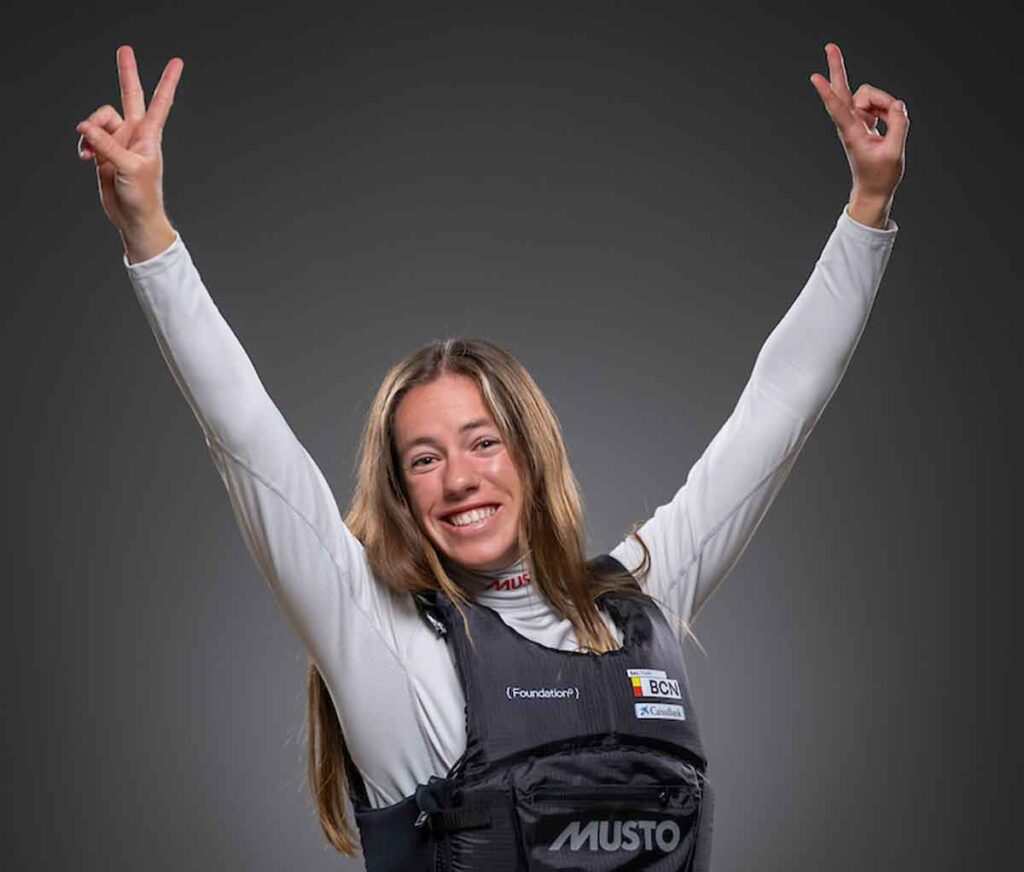
Silvia Mas, who helmed the local invited squad, was at an even greater disadvantage from the get-go: Team BCN didn’t have access to an AC40. “We were doing it all with a simulator,” Mas says. “It was hard to find a coach who was really experienced in the AC40, because all those coaches were already in the big teams.”
Mas finally convinced Will Ryan, of Australia, an Olympic gold medalist and teammate from her TP52 sailing, to assist. “I was like, Will, please, we don’t have that much money, but please, can you help us. He did a very good job.”
Clapcich, born in Italy and married to US Olympian Sally Barkow, says that once the American Magic women’s sailing team was finalized over a long selection process, they trained on the simulator at the team base in Barcelona—between other commitments. Co-skipper Erika Reineke was immersed in her Olympic ILCA6 campaign, and Clapcich had her hands full with UpWind, a women’s Ocean Fifty trimaran program for the 2026 Route du Rhum. “It was hard to get the entire sailing team together for a long amount of time,” Clapcich says, “and time is the one thing that we all crave all the time.”
She adds, however, that it was important to be realistic about expectations. “I don’t think it would have been fair to have to quit everything else for an event that was just four days long.”
To sail an AC40, the American Magic women relocated to Badalona, Spain—where the invited Swedish Challenge team and INEOS Britannia’s Athena Pathway sailors were also training. “It was a really good way for us to be super-focused on what we were doing,” Clapcich says, “but at the same time you lose a little bit of the top fire that being with the big team brings.”
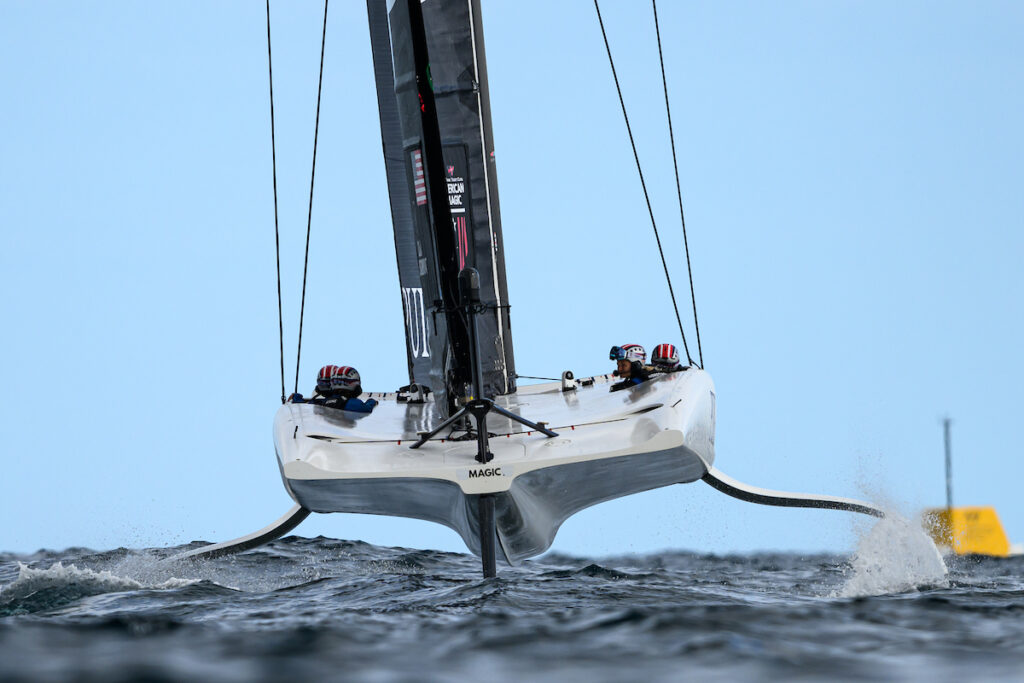
Working with American Magic’s Youth America’s Cup team did help, however. “Harry Melges and Severin Gramm were definitely the two [youth] sailors that had the most hours on the AC40,” Clapcich says. “When we started sailing, sometimes I was driving on port and Harry was driving on starboard. He was kind of like an onboard coach, and that was valuable for us.” She pauses to wish aloud that some of the women had been similarly included into the Cup team early on. “Even an hour of sailing here and there when they needed a spare driver or a spare trimmer would have increased our time on the water,” she says, “but that would probably not even have been possible, with all the other projects that we had.”
Over at Luna Rossa, the Women’s team’s sailors were not allowed to be distracted with Olympic campaigns. They operated as a single unit with the Youth team sailors, who also won their event. “We were super integrated with the America’s Cup team,” Conti says. “We were sharing the same facilities in Cagliari and in Barcelona; training out of the base, and interacting every day with everybody. Amongst all the teams, probably us and the French were the ones that most interacted with the big team.”
Looking at the results, though, that was not their sole source of success. “We were super integrated,” Conti repeats, “and the British were completely independent—and we were the two best teams.”
Skills Of A Younger Generation
As the Cup-aligned teams trained on their AC40s, the independent teams had to scrounge for time on the water. Mas says they rented a boat to supplement the four official training days, but technical glitches and weather inconsistencies meant they’d only logged a few hours of sailing before the racing went live.
All three skippers say the simulator was excellent preparation, though they have different opinions about how directly it translated—which may be partly related to their ages. At 39, Conti is more than a decade older than her Luna Rossa teammates; she compares even the actual sailing to playing a video game. “You’re just pressing buttons and moving joysticks and driving wheels. Everything happens so quickly. And obviously, a young brain processes things differently than the older one. It took me a little longer than the young girls to get it for sure.”
Clapcich, 36, says the simulator is surprisingly realistic—but she missed the sensory input. “On the boat,” she says. “You have the wheel in your hand and you can feel the balance of the boat so much better.”
While the simulator gave her a full understanding of the platform, the trick was “trying to get the hours on the water to transfer that knowledge.” And, on or off the water, “the teams that were able to spend a lot of time together will also have more chemistry, and that definitely makes the entire team more successful.”
The 28-year-old Mas says the simulator is “really helpful in the way of mechanism in the brain: what is happening if you do this or you do that. But the takeoffs are completely different in real life, and if there is a strong wind it’s not that accurate. And you don’t have the feeling of the heel, which is something super important in these foiling boats. But it was a very big tool for us—well, the only tool we had, of course.”
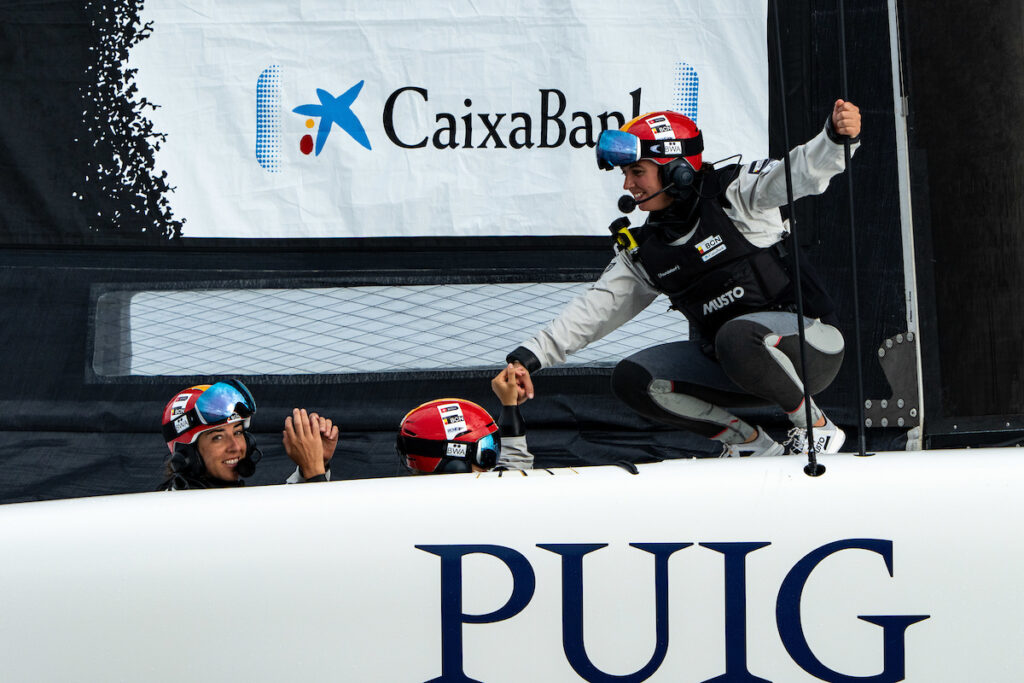
To simulate racing situations, the Spanish team’s coaches layered on artificial stress. “In the simulator, you are tranquil, chill; life just happens,” Mas says. “So, they were like, there’s a boat right here and things are going on super-fast! They were doing to us things that were exploding our heads…because they wanted to simulate all the drama in real sailing. It was a mess, but I have to say that thanks to that, when we went on the real boat the team was much better prepared.”
Monster Operations
Shortly before the regatta, all the AC40s used by teams for training and development for the AC75s were transferred to the America’s Cup organization and returned to their one-design state. “They organized a full technical team to take care of six boats,” Clapcich says. “It was quite a monster project for them.”
Sailors—and viewers of the race broadcast—were frustrated by random breakdowns, but Mas says the time her team spent digging for solutions actually made them stronger. “We knew we didn’t spend time on the boat, so we were like, OK, even though everyone has their responsibilities everyone has to also look after the other one. Normally there is always a specialist to tell you: if this happens, you do this. But this time, we were actually the ones on the laptop. You can imagine how many hours…Why this? I don’t understand. But you look and look and take in as much information as possible. And then on the water, we could analyze faster because we were really working on that, learning minute by minute. Trying to really understand the boat; I think this is what really made the difference.”
Conti says the boats themselves are not difficult to sail, but rather, “the hard part is all the operations—going alongside the chase boat, towing, and all these little things where you risk the worst damage. Clapcich’s opinion of the AC40 is that it is “quite a complicated boat…you cannot just turn the wheel.”
Mas identifies what is, perhaps, the AC40’s best attribute: “These boats are so technical; we don’t really need to be that strong.”
And this point, of course, translates to the AC75s that will be used for the next Cup cycle. If, as some pundits predict, the cylors will be replaced by batteries, then brute strength and power should no longer be a requirement.
The door is then blown wide open for the now experienced sailors of the Puig Women’s America’s Cup. In the meantime, all three skippers are eager to do more AC40 sailing—and as of this writing, they are still awaiting word about whether that will be possible. “It would be great to have a series, because we enjoy racing against each other,” Conti says, before adding that there’s now a group of women with enough experience to “fight for the hot seats in the AC 75s.” Luna Rossa has ordered a second AC40.
Conti’s best memory is crossing the finish line as the Puig regatta’s champion, but she says the scores are not the whole story. Before the first day of racing, “I told the girls that however this event would go, I’d already won because I’d found them. We created such a tight group, not only in a sportsman way, but also from a human point of view. They became like my family. Very good friends, very good people, very good sailors. We were actually doing stuff together outside the boat every day.
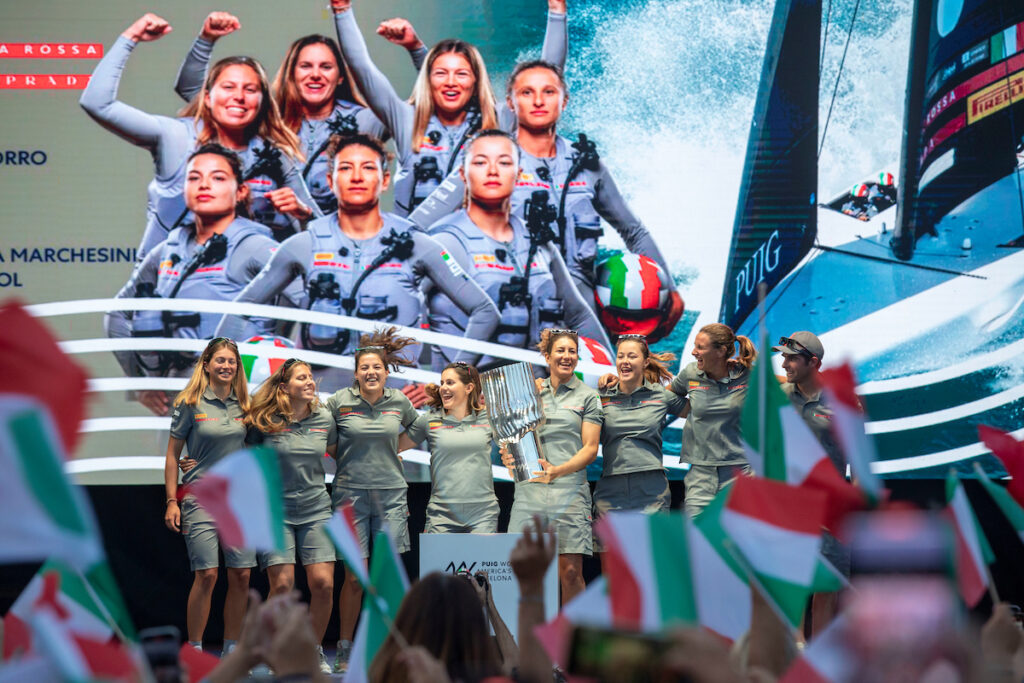
“Achievements are good,” she adds. “And they define your career. But what you really take with you is the people and the moments that you live. I had the best year of my life.”
Clapcich says that American Magic management pursued feedback and the women were happy to give it. “We shared what we did well, what we didn’t do well, and what can get some improvement. I think they are open about trying to make improvements for the future. [But] the America’s Cup is a hard one, because one team wins and they make their own rules and it’s not really controlled by anything above them.”
Mas has advice for future America’s Cup teams: “The men should be scared. We can really do it. I hope we can see mixed crew in the future—or even a full women’s crew. Why not? I really believe in that, and I think we are really getting there.”
When and if there is a there it may well be uncomfortable at first, but then, just like Conti says about high speeds, it will quickly become automatic.

